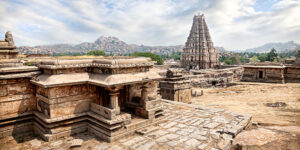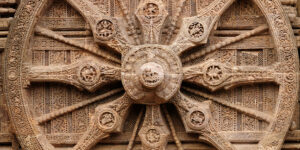This Roundtable discussion at the World History Association Conference, examines the ongoing problems associated with the Aryan Invasion/Migration Theory, and the controversies involving the late-18th and 19th-century origins of this theory and its explicit service to European national and colonialist interests and agendas.
This historiographical controversy centers on academic arguments that still dominate the field, continuing outmoded Western Orientalist paradigms that persist in today’s area studies, despite a rich and growing body of evidence and scholarship to the contrary. The problem is deeper than that of historiographical and cultural misrepresentation, however, involving a kind of intellectual ownership of the historical narrative. Grounded in European Indology and imposed on the history of India, the Aryan Invasion / Migration Theory, emerges as an ideological and less-than rational set of ideas.
The term Aryan appears in numerous Hindu Sanskrit texts, and the earliest references to the word Aryan can be found in the Rig Veda. Most famously, Krishna chides Arjuna for being “Un-Aryan” (Anaryajushtam), in the Bhagavad Gita (2.2), when he is stricken with pity and sorrow on the eve of battle. The Indian, indigenous and Hindu meaning of the word Aryan is “noble” or “worthy” or “exalted” and represents a human being of high character, learning and wisdom—basically a person who manifests sophisticated conduct and behavior towards others. When we consider that the four Noble Truths of the Buddha are “Arya Satya” we can safely say that “Arya” was a general descriptor within the Indian culture for anything exalted, sublime, noble, sophisticated, etc.
It is when this Sanskrit word enters European vocabulary that it begins to acquire a completely new meaning. A German Jesuit Missionary, Heinrich Roth (1620-1668) is the earliest known European Scholar of Sanskrit, who acquired his knowledge of Sanskrit from Brahmin Pandits in Agra. During his stay in India (1652-1668), he wrote a Sanskrit Grammar in Latin in the year 1660. Another German Jesuit Missionary, Father Johann Ernst Hanxleden (1681-1732), wrote a Latin Grammar of Sanskrit called Grammatica Grandonica, during his stay in India from 1700 till his death in 1732. These efforts spawned a considerable interest in Sanskrit, in Germany, pre-dating British curiosity about Sanskrit which came several decades later. The first Sanskrit manuscript, that found its way to England, was acquired by the Oxford’s Bodleian Library, in 1666 from John Ken, an East India Company merchant of London. Oxford University’s collection of Sanskrit Manuscripts greatly expanded in 1740, when British Author and collector of “oriental” manuscripts, James Fraser, (1713-1754), and one of the first Britishers to acquire a working knowledge of Sanskrit from Brahmin Pandits in Surat, brought a collection of forty-one Sanskrit manuscripts. Interest in Sanskrit began to spread throughout Europe, by this time.
The groundwork for the idea of an “Aryan” people was first developed by Abraham-Hyacinthe Anquetil-Duperron (French Orientalist, 1731-1805), who lived in India for seven years (1755-1761), and published a three-part Zend Avesta ascribed to Zoroaster, in 1771, where he associated the term Aryan with the Indo-Iranian people. It was not until 1786, when British Orientalist, William Jones (1746-1794), discovered that Sanskrit and Persian were related to Latin and Greek, within what later came to be called the Indo-European or Aryan family of languages. German scholar Karl Wilhelm Friedrich Schlegel (1772-1829) published in 1819 the first theory linking the Indo-Iranian and the German languages under the Aryan group.
Slowly, however, Aryanism as a system of thought transformed what began as a theory about a family of Aryan languages into the study of races i.e. mankind as classified into different “races.” Christian Lassen (Norewegian, 1800-1876) first suggested the idea that the Aryan people had invaded India from Europe or Central Asia at some hoary time in the past, which could perhaps “explain” the linguistic affinities between so wide a group of languages such as German, Latin, Greek, English, French, Persian and Sanskrit. The term Aryan began to be adopted as a racial category through the works of Arthur de Gobineau (French, 1816-1882), whose ideology of race was based on the proposition that blonde northern European Aryans had migrated across the world and founded all major civilizations, before being degraded through racial mixing with local populations. As this stream of thought centered on Aryanism evolved further, Bishop Robert Caldwell (1814-1891), a missionary and linguist, who contrasted the Dravidian family of languages with the Aryan, Max Mueller (German, 1823-1900), who wrote extensively on the Aryan language family and Sanskrit texts, and proposed for the first time a possible date for the Aryan invasion to be around 1500 BCE, Charles Morris (American, 1833-1922), author of the “Aryan Race, 1988”, and many others such as Houston Stewart Chamberlain (German-British, 1855-1927) who turned Aryanism into Anti-Semitism, Gustaff Kossinna (German, 1858-1931), who identified the Germans as the most exalted amongst Aryans, began to progressively advance the claim that the Aryan race was innately “superior” i.e. more creative and morally upright than “inferior” races such as Semites, Negroes and others, eventually mutating into the Nazi racial ideology resulting in the Holocaust.
The Aryan Invasion/Migration Theory, essentially implies that the Indians i.e. Hindus on their own, do not have the capacity to engender a civilization of their own. Whatever civilization they created in the past, as mentioned in their various literatures and manifested through art, architecture, drama, poetry, science, mathematics, etc. is basically based on a gift of the people with European ancestry who migrated to India sometime in antiquity. Their Vedas, Upanishads, and various other yogic darshanas including Buddhism and Jainism could not have been created on the Indian soil had the superior Europeans (i.e. the Aryans) not migrated to the Indian subcontinent in the past. In other words, the indigenous Indians are fundamentally savages and uncivilized people having no agency or capacity to build a civilization. Further, whatever modicum of civilization that Indians may have in the current times is also based on the more recent European gift of British colonization. The Aryan Invasion Theory—and its politically correct version the Aryan Migration Theory—essentially freezes and perpetuates the racial and civilizational superiority of the people with European ancestry over Indigenous Indians.
When internalized in its current form, most Indians suffer from an exacerbated sense of inferiority complex in relation to people with European ancestry. It adversely impacts the Indians in India, Indians who come out of India and are in professional and personal contacts with the Caucasian people, and Indian Americans who grow up here in the United States. It is particularly insidious for the second generation Indian Americans, who begin to experience inadequacy and anxiety about not being White enough, and often distance themselves from the heritage of their parents, usually leading to an inter-generational conflict and sometimes ending in a permanent fissure in the family.
The Aryan Invasion/ Migration Theory is increasingly being challenged by Indigenous scholarship that is continually suppressed in mainstream academic discourse. Based on evidence, Indians have challenged this theory right from its inception. The challenge became more intense with the discovery of the ancient cities of Harappa and Mohenjo-Daro—commonly known as Indus Valley Civilization or Harappan Civilization, which Western Indologists designated as a Pre-Vedic civilization. Post-independence an army of researchers have not only established the existence of the once-mythical-river Sarasvati but have also found numerous ancient (close to a thousand sites) on its banks. Yet, the mainstream academia continues to address the civilization as Indus Valley Civilization instead of Sarasvati-Indus Civilization or Sarasvati-Sindhu Civilization. One of the unstated and subterranean reasons for disallowing the acknowledgment of Sarasvati in the mainstream academia is because the substratum of the Indian culture—the Veda and the Upanishads, based on its own internal evidence, emerged on the banks of Sarasvati. All attempts to link the Harappan Civilization with the Vedic civilization are opposed tooth and nail in the dominant mainstream academia, today, for two reasons: a) because the Euro-centric thesis that the Vedic culture of India, is a post-Harrapan principally Aryan phenomenon, which happened after 1500 BCE, whereas the Harrapan civilization, more appropriately called the Sindhu-Saraswati civilization dates back to well before 3000 BCE, and b) because with the link the Indians and the Hindus not only become creators of a profound spiritual and yogic culture as described in the Vedas and the Upanishads, they become the creators of a great material culture as well – and this strikes at the very root of the colonial discourse of Indians and Hindus being an inferior and other-worldly people, who by definition are incapable of, and uninterested in creating any civilization, material or otherwise, without foreign i.e. Aryan aid.
Many aspects and cultural practices, including the city building plan, of the Harappans continued till the historic times as is evidenced in the excavation of a six hundred BCE city of Shishupalgarh by B. B. Lal, the erstwhile Director General of the Archaeological Survey of India and a renowned archeologist, and its incorporation in the Arthashastra of Kautilya. B. B. Lal has also shown how farming methods, plan of building houses, ornaments used by female populace including artifacts for wedding ceremonies, bedtime tales, lapidary methods, cooking methods including the use of pots and pans, games like chess, toys used by children, writing pad, etc. have continued to find their use in the current times in areas surrounding the Harappan civilization. In addition, figurines showing the traditional Hindu greeting Namaste, yogic poses later compiled in the Yoga sutras of Patanjali, fire alters used in Vedic ceremonies, seals depicting the Hindu Deity Shiva, iconic representation of Shiva in the form of Shivalinga have been found in various sites of the Harappan culture. The above show the Vedic and indigenous roots of the Harappan culture rather than what the mainstream discourse argues for.
And yet the indigenous voices as in the above continue to get suppressed and silenced. The Aryan Invasion Theory has been replaced by the Aryan Migration Theory – but whether invasion or migration, essentially it is the same Aryans coming from outside the Indian subcontinent, who have given the Indians any semblance of civilization, however other-worldly or material that it may be. Today, talk of the “Aryan race” in the West is restricted to white supremacist circles in North America and neo-Nazi militants in Europe. The very concept of “race,” although it is still used in political discourses, especially in the United States, is scientifically bankrupt. Yet, School text books across the USA and India continue to serve up the near scientific objective truth of a supposed Aryan migration / invasion into India that took place sometime around 1500 BCE, masquerading the racist underpinnings of the earlier theory under the politically correct linguistic version of Aryans as people carrying Indo-European languages from one place to another as they migrated from some place in Europe. Such is the mainstream academic blind-spot i.e. its patent racism, that despite almost all nationalities in Europe having claimed the origins of the Aryan people in their land, it does not question the veracity or the “scientific” truth of the migration of the Aryan people from Europe to the Middle-East to India. This Aryan invasion/migration of India is presumed to be the explanatory schema that undergirds all attempts to understand India, i.e. its Caste system, Brahminism, Untouchability and the numerous human rights violations that India is routinely accused of by most current day South Asia studies scholars, who regurgitate and reinforce orientalist narratives, through long chains of citations, without acknowledging the ever-increasing body of new evidence.
Portrayals of world cultures and history remain central to the goals of World History with an aim to restore—or to establish for the first time—Indigenous agency to the historical narrative, respect for traditional cultures and values, and sensitivity for what World History Association President Rick Warner has described as “cultural empathy.” At least in the case of India, such a restoration is long overdue, but it will have to address the huge white elephant in the room, which is fair, blond, and blue eyed.


